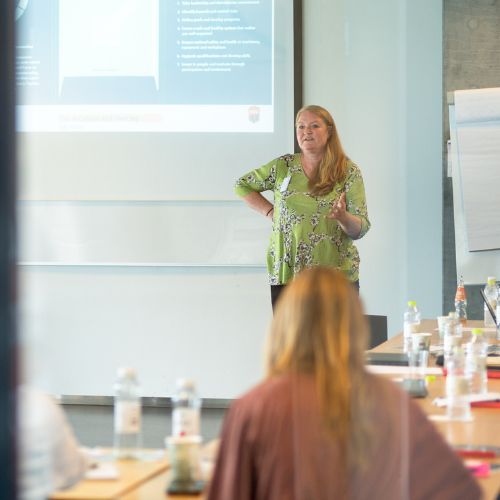
President of OSH Africa: We need managers and supervisors to play the right kind of tunes, so that the rest of the workers may dance the right kind of dance
The COVID-19 pandemic triggered changes in the workplace and heightened the significance of mental health and employee wellbeing. Leadership, from boardrooms to managers, plays a pivotal role in addressing these challenges, and achieving a healthy work-life balance is essential. Here, the President of OSH Africa, Ehi Iden, shares his thoughts on the matter:
The COVID-19 brought forth a revelation of things that we knew were in existence but never had the boldness to make definite actions on even while we talked about them in several quarters. We saw the disruption that came with the COVID-19 pandemic pushing so many frontiers, digging up things that we thought were for the future forcing us to fix them in our immediate present rather than wait for the future as predicted by so many studies.
One of such disruptions touched on the Future of Work when the global prediction was on 2030 where work and patterns of work were expected to experience dramatic change due to the growth in global technology and how these technologies were fast changing the ways work were done. This was what we all anticipated before the pandemic which forced the entire world to a complete lockdown with remote work taking a centre stage against a popular view that we must all be physically present at work to get work done. The pandemic heightened the issue of mental health and employees’ wellbeing while we saw healthcare workers getting overwhelmed by work in excess leading to a number of COVID-19 related suicides among healthcare workers globally.
Significantly, the pandemic revealed the elephant in the room and highlighted the underlying mental health burden of work, working environment and workplace management systems. This has further brought two main items “Mental Health and Wellbeing” into the workplace conversation and the need to strengthen this conversation is our collective responsibility. We need workplace leaderships to set the right stage, we need managers to play the right kind of tunes on this stage so that employees can put up the right kind of performance. Such synergy in commitment to roles and responsibilities is capable of improving the mental health and wellbeing of employees and employers alike.
The importance of addressing mental health and wellbeing
Mental Health and Wellbeing are so closely related, and it is most times difficult to talk about them separately. According to the definition of the World Health Organisation (WHO), “Mental Health is a state of mental wellbeing that enables people to cope with the stress of life, realise their abilities, learn well and work well, and contribute to their community”.
But wellbeing, on the other hand, seems to be the new element of interest whose globally acceptable definition is still a subject of deliberation amongst global schools of thoughts. One clear evidence in the definition of mental health is the presence of the word “wellbeing” even within the definition. But as also stated by WHO, wellbeing encompasses the quality of life, the ability of people and societies to contribute to the world with a sense of meaning and purpose.
These two elements are part of employees that we must help protect and preserve by policies and actions, because when employees lose these, they lose it all. The overall impact of poor management of workplace mental health and wellbeing are cumulative, the outcomes are never instantaneous, they most times take even a decade to manifest or even when employees have fully retired. Considering that there is life after retirement, it further builds a strong motivation why we should look into what goes on with and within employees while they are under our supervision.
For the past two decades, workplaces have been unduly invaded as a result of the speed of growth in the world of technological leading to sudden change in work patterns through process automation. Global competitiveness has also left no stone unturned as the continuous drive for market competition and business successes have continued to leave a huge toll and mental health burden on employees. There would have been hope in sight but the sudden new transition to artificial intelligence creates further concerns on the possible increase on the burden of mental health and wellbeing of employees in the new age. While we all may look physically well in our current state, we need to anticipate the possible internal damage that work, and work-in-excess could do to our wellbeing.
No sector or industry is spared from this challenge, the factory worker is as exposed as the healthcare worker is, the need for global leaders and employers to see this as needing urgent attention is imminent.
Prioritising mental health and wellbeing from the boardroom
Having identified a number of changes in workplaces leading to the heightened level of mental health and wellbeing at work, it is important to also examine the human component within these concerns. Every organisation needs the right kind of leadership that prioritises the mental health and wellbeing of employees – this must begin from the boardroom. We all need board members that do not only look at how the Chief Executive Officer grows profit, we need a board that is honest enough to ask the impact of the posted profit on the mental health and wellbeing of employees, we need to grow this part of our business (employees’ wellbeing) just the way we grow profit.
If such conversation and thinking is sustained within the board and they are able to say to the CEO “Are you ok?”, then we will have a CEO that will look out for the mental health and wellbeing of employees. We need this traction to begin from the top that it may flow down naturally. Listening to several conversations and reading across many literatures, we see “the mental health and wellbeing of employees” but sadly, we hardly hear about the mental health and wellbeing of employers. It is high time we start taking note also of what happens with the employers and how much they overdraw themselves for the organisation to succeed. Even in most workplace policies, we see mention of “employees” and not “employers” and by default, we forget that employers are also human beings like every employee who needs to be looked out for. This has to change.
While it is important to re-establish, that workplaces wear on employees’ mental health and wellbeing, we need to urgently start looking into how employees are managed and responded to by their reporting lines. Workload, longer hours of work, workplace violence and harassment are grossly inimical to workers’ wellbeing improvement; these are not only enabled by our quest for increased productivity and tight deadlines, they are indirectly fuelled by the level of competence of our managers.
We must keep in mind that employees not complaining does not mean they are not struggling. The more we allow people to speak out, the more we have to initiate systems improvement programs. At the centre of this freedom of speech workplace approach should be conversation on employees’ mental health and wellbeing, the urgent need to elevate the voices of employees along these lines can never be over emphasised.
Enhancing the quality of life for employees after retirement
With so many studies alluding to the fact that we spend a higher number of our wake hours in workplaces and with the recent extension of retirement years across many countries, it has become clear that employees will spend a larger portion of their entire existence in workplaces and this again is a motivation why workplaces should be made safe and healthy in the interest of employees. It is also very important to understand that life does not end at work, there is life at retirement and there should be something left in and within employees to live a healthy life even at retirement.
Sadly, the ills and exposures employees are subjected to during their work life mostly find medium of expression years after and this spans into retirement years. Burnout as a clear example has repercussions on personal lives of employees, this ranges from feeling unhappy, anxiety, depression, isolation, substance dependence and abuse and many more. When we imagine a single employee living through this for an average of 35 years of his or her entire life, predictably retirement could be hell because workplace must have adversely affected the employee’s work life as well as retirement.
Fatigue, longer work hours, workload, harassment in any form, discrimination at work and all related issues have closely knitted mental health and wellbeing adverse effect on employees’ personal life at work and even life at retirement.
Setting the stage for positive change
For workers to be able to live healthy and enjoy their retirement lives call for a rethink of the existing workplace management systems, work processes, work patterns and prioritisation of human capital. People need to retire and indeed retire happily and able to do better things with their lives afterwards knowing that their health and wellbeing were duly prioritised and cared for all through their work life. While it is easy to look at what has not been made available in workplaces by employers, we need workers also to take personal responsibility over their mental health and wellbeing. There is only so much that the organisation can do, we need employees’ personal involvement.
Keeping in mind that mental health and wellbeing outcomes is a combination of workplace exposure and employees’ family exposure also, the need to balance work and personal life in our interest is a profitable consideration. While we work, let’s keep retirement in mind so that we are able to make reasonable contributions to our community and able to do what we love even at retirement.
In our collective efforts towards building safe and healthy workplaces and systems, there is the urgent need to clarify the lack of understanding of what wellbeing really means and continuously reinforce the fact that mental health is also a workplace issue of concern needing our honest attention. It is important to highlight that mental health has a globally accepted definition of reference and we struggle when it comes to the definition of wellbeing; this is sketchy and the need for a globally accepted definition on wellbeing will be a great step towards demystifying the existing misunderstanding on wellbeing and its true meaning. The urgent call for boards and leaderships of corporations to think through the impact of work on the mental health and wellbeing of employees, this should guide how tasks, roles and demands are assigned.
We need board members to speak out for mental health of both employees and employers, we need management of organisations to set the right kind of stage, we need managers and supervisors to play the right kind of tunes so that the rest of the workers may dance the right kind of dance. This is the only way we can all see and feel that change.
Ehi Iden, President of OSH Africa



